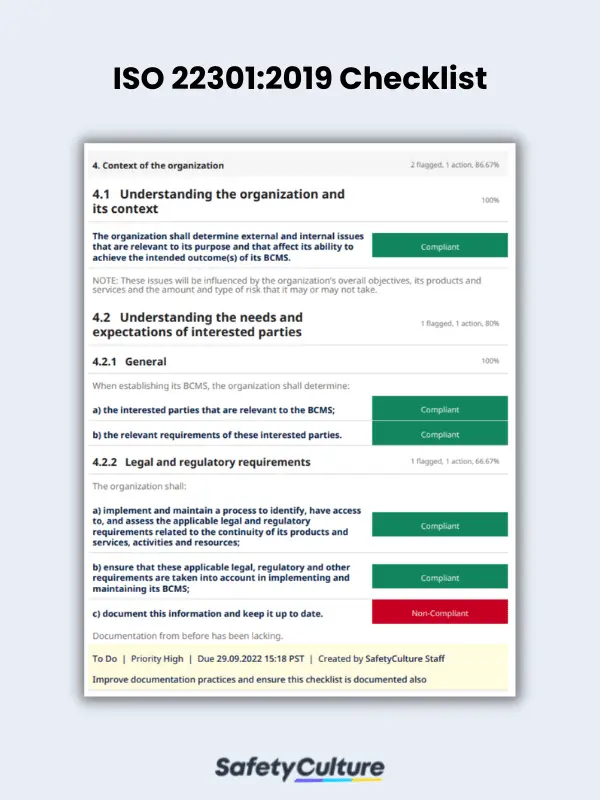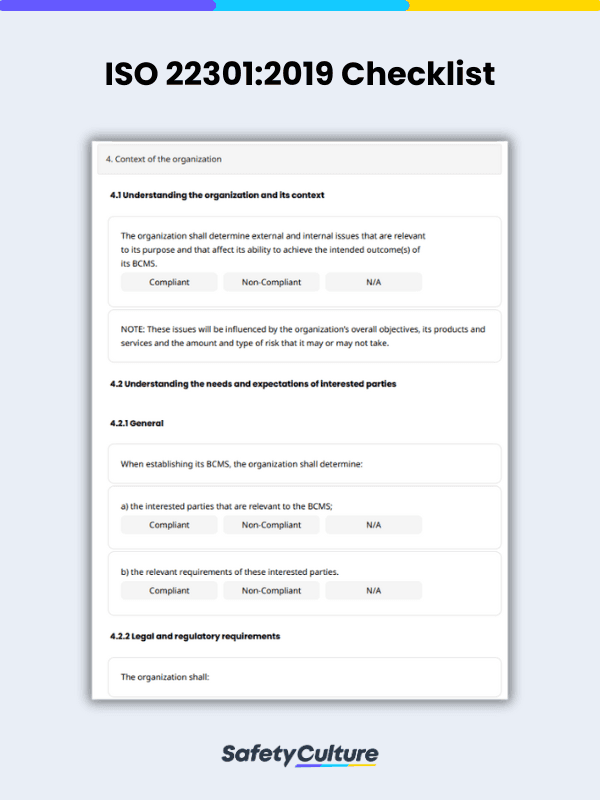What is an ISO 22301 Checklist?
An ISO 22301 checklist is used to ensure business continuity in times of emergencies, issues, and other possible disruptions. The ISO 22301 checklist is applicable for all businesses of all sizes, as it can help with implementing business plans and ensure standardization in quality metrics and regulations.
What is ISO 22301 Used For?
ISO 22301 details the requirements for implementing, creating, and maintaining a business continuity plan (BCP), a business continuity management system (BCMS), and other related legal and organizational regulations.
While sounding similar, there is a difference between a BCP and a BCM. A BCP is more focused on the scenarios a business should be prepared for. On the other hand, a BCMS aims to help businesses cope with events that affect their processes and activities, such as server issues or facility breakage.
Some aspects of a BCP and a BCMS that ISO 22301 tackles are:
- The importance of understanding the organization’s needs
- The necessity for establishing continuity plans
- The operational processes, capabilities, and response structures that need to be maintained for different situations
- The continuous improvement of business processes based on qualitative and quantitative data
By using and complying with ISO 22301 standards and applying the Plan-Do-Check-Act (PDCA) cycle as directed by the document, businesses can reduce their financial losses in case of unexpected events, create a competitive advantage, and protect their people and their environment. Doing so also ensures consistency in business operations and strategies, making it easier to use ISO 22301 with other ISO standards, such as ISO 9001, ISO 14001, and ISO/IEC 27001.
What are the Elements of an ISO 22301 Checklist?
An ISO 22301 checklist can be used by anyone in an organization. It can be accomplished by business owners from a top-down level in order to implement changes company-wide. It can also be used by managers in the mid or lower levels to create new policies.
A typical ISO 22301 checklist should include the following sections:
- Context of the organization – For understanding the organization, its context, its interested parties, its BCMS, and its legal and regulatory requirements
- Leadership – For analyzing the current leadership policies and practices in place as a whole and in connection to business continuity plans
- Planning – For determining risks to prepare for and the plans to address them
- Support – For the communication tactics to utilize in different situations, documentation processes to implement, and the level of competencies required for different staff
- Operation – For conducting risk assessments, creating business continuity operational plans to follow, and the order in which to do so
- Performance evaluation – For conducting an analysis of the business continuity plans, the BCMS, and other internal auditing tasks
- Improvement – For identifying points for improvement

ISO 22301:2019 Checklist Template | SafetyCulture
FAQs about ISO 22301
Both ISO 27001 and ISO 22301 are used for creating and implementing protective strategies in a business environment. However, the difference between them is that ISO 27001 focuses on protecting a business against cyber threats, and ISO 22301 is on ensuring that a business will still operate, regardless of threats, including cyber ones.
ISO itself does not certify businesses. Instead, there are different auditing and accreditation firms that certify businesses for them. To get certified, visit an accredited certifying body near you.
ISO 22301 certification is valid for three years only. If you want to stay certified, you must renew your certification.



